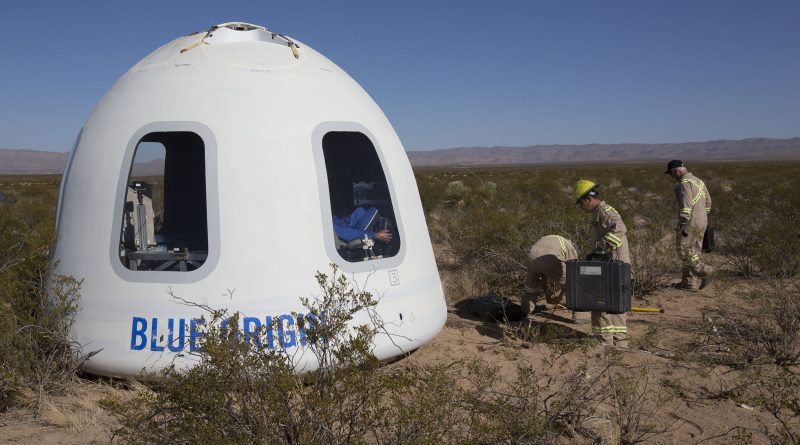Blue Origin Resumes New Shepard Testing with Crew Capsule 2.0 & “Mannequin Skywalker”
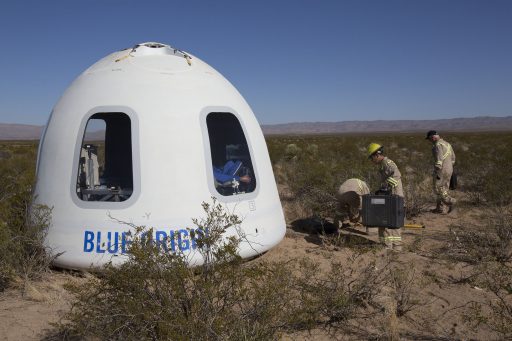
Blue Origin, after a 14-month hiatus, has resumed test flights of the company’s New Shepard sub-orbital launch system on Tuesday – debuting a new Propulsion Module and Crew Capsule 2.0, featuring large panoramic windows and upgrades for rapid re-usability for tourist and science missions to the edge of space.
Tuesday’s flight, the seventh for New Shepard, was crewed by an instrumented dummy named “Mannequin Skywalker” as Blue Origin works toward initial crewed missions in 2018.
Blue Origin conducted its previous test flight in October 2016 when demonstrating the in-flight abort capability of the New Shepard launch system that would pull the crew capsule free of the Propulsion Module in the event of trouble on the way up. The test marked the fifth flight of this particular Propulsion Module and the sixth for the Crew Capsule Prototype, both of which headed into retirement after the abort demonstration.
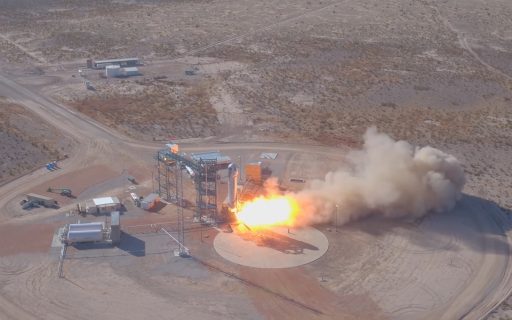
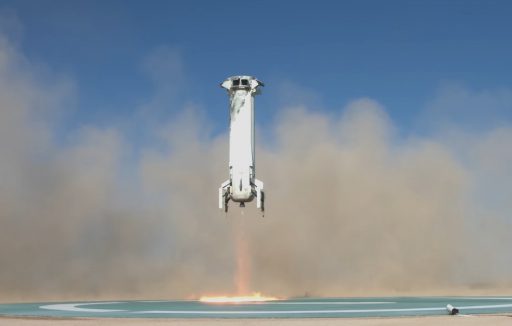
The focus of the test program thus far was on demonstrating and improving the nominal mission architecture of New Shepard and demonstrating abilities to deal with off-nominal situations like parachute failures. These flights used a prototype version of the company’s Crew Capsule without windows and crew accommodations.
Crew Capsule 2.0, debuting on Tuesday, is fully outfitted for crewed missions including seats and 73 by 110-centimeter windows for all passengers – the largest windows ever flown on a spacecraft to provide paying customers with a spectacular view of the planet.
The Propulsion Module, New Shepard 3, had been completed and shipped to the launch site by September to begin final acceptance tests before resuming Blue Origin’s test program, now focused on final qualification for crewed missions. Some changes have been made on NS-3 including a beefed-up thermal protection system to further reduce the wear and tear incurred during regular missions and lessen the extent of refurbishment needed as part of the operational program.
Tuesday’s test flight, unlike the previous two that were broadcast live by Blue Origin, was kept out of the media spotlight with no prior notice by the company except for air route closures over the West Texas launch site issued last week, specifying a test window from December 11 through 14. The Federal Aviation Administration provided confirmation that a test had taken place but Blue Origin remained silent for eleven hours after the test until company founder Jeff Bezos Tweeted a video of the test flight.
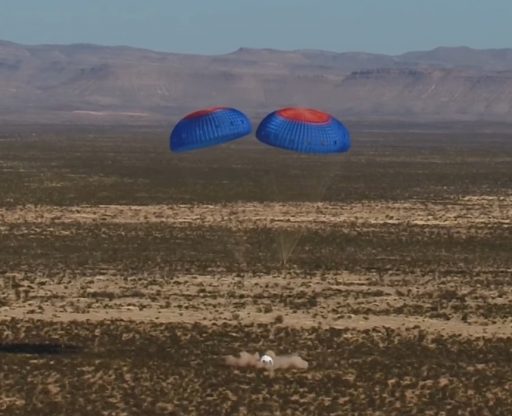
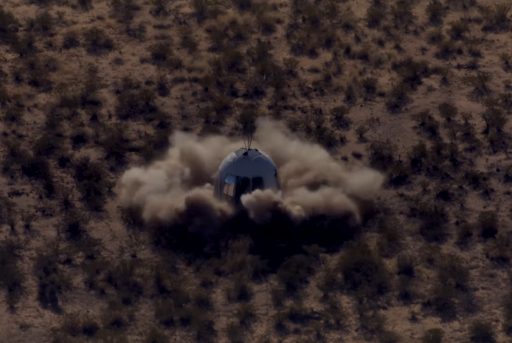
New Shepard lifted off at 16:59 UTC, rising from its pad powered by the 50-metric-ton-force BE-3 engine burning a cryogenic mixture of Liquid Oxygen and Liquid Hydrogen. The straight-up ascent began with a powered flight phase of under two and a half minutes, reaching a peak speed of Mach 2.94. NS-3 and Crew Capsule 2.0 went on their separate ways around thirty seconds after engine cutoff, continuing to climb to an apogee of 99.4 Kilometers for the capsule and 99.3km for the New Shepard booster.
Passing the high point of its trajectory, the NS-3 booster entered a vertical descent with a top speed of Mach 3.74, stabilized by its forward wedge fins before deployment of eight Drag Brakes began the process of slowing the vehicle down for the landing burn. Re-starting the BE-3 engine, the vehicle slowed down into a constant velocity descent of three meters per second for touchdown on four deployable landing legs.
The crew capsule’s flight lasted ten minutes and six seconds, touching down under three blue-and-orange parachutes and with help of soft landing engines that slowed the vehicle to less than 0.5m/s for touchdown.
Strapped into one of the seats of the Crew Capsule was ” Mannequin Skywalker” – a dummy outfitted with various instruments to characterize the flight environment from a human perspective with focus on forces during the rocket-powered climb, vehicle body rates during the turbulent parachute deployment sequence and the force occurring at touchdown. Also aboard Mission 7 were 12 commercial, research and education payloads flown by NanoRacks and ranging in size from student-operated NanoLabs flown in the company’s Feather Frame to large professional-grade payload lockers facilitating larger experiments conducted during the brief microgravity phase of the flight.
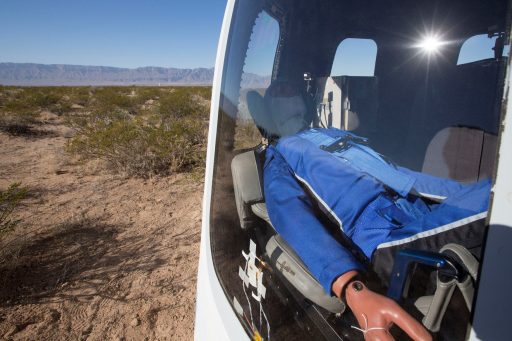
Mission 7 was the first carried out under a commercial launch license issued to Blue Origin by the Federal Aviation Administration in August, upgrading from an experimental permit that did not allow Blue Origin to utilize New Shepard for commercial experiment payloads. Under the new license, the company can market flight opportunities for payloads on the remaining test flights and begin driving in revenue before starting operational flights.
“Today’s flight of New Shepard was a tremendous success. It marks the inaugural flight of our next-generation Crew Capsule as we continue step-by-step progress in our test flight program,” Bob Smith, Blue Origin CEO, said in a statement. “Congratulations to the entire Blue Origin team on a job well done and to our payload customers that gathered important data on the suborbital environment.”
Blue Origin hopes to start crewed test flights of New Shepard and its Crew Capsule in 2018 and beginning commercial services shortly thereafter, lifting crews of up to six to the edge of space to enjoy the sight of Earth’s curvature and the sensation of Zero-G.
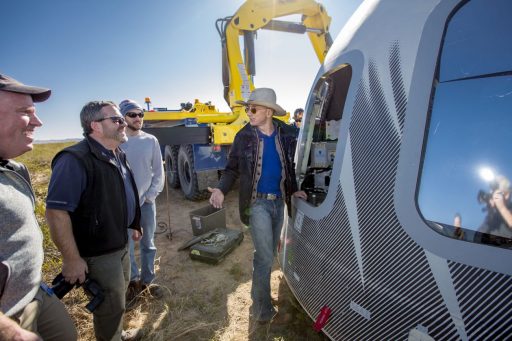
In addition to tourist missions, New Shepard is envisioned to become a platform for science missions of all kinds, offering three minutes of very high-quality microgravity at an affordable cost for experiments that could not be realized on an orbital mission due to budgetary limitations. One selling point of New Shepard is its high launch pace, allowing for repetition of experiments under different conditions or with changed hardware not easily possible with an orbital mission.
The resumption of New Shepard testing comes in a busy time at Blue Origin with efforts underway at multiple locations of the U.S. focused on getting New Shepard to an operational stage and lifting the company’s New Glenn rocket off the drawing board and onto a launch pad. While New Shepard enjoyed a very successful test campaign at the company’s West Texas testing grounds, the facility is also used for development testing of Blue Origin’s large BE-4 engine that will power the New Glenn rocket.
In Florida, Blue Origin is nearing completion of its large production facility at the Kennedy Space Center and work is also underway to ready Launch Complex 36 at Cape Canaveral Air Force Station for an inaugural launch of New Glenn in 2020.

